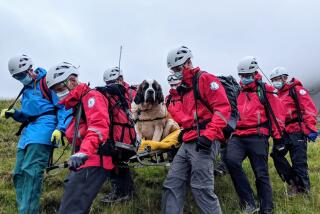Alpine Home of Famed St. Bernard Dogs Gets Low Marks From Swiss Kennel Club
- Share via
GENEVA — Switzerland’s legendary St. Bernards, famed for rescuing snowbound travelers, now need help. Animal experts say it will take more than a cask of brandy to rescue them.
The hefty dogs spend at least 20 hours a day in cramped quarters that are unheated even in freezing weather, according to experts who visited their kennel at a hospice near the 8,110-foot Great St. Bernard Pass.
The findings have prompted the Swiss National Kennel Club to impose a temporary ban on breeding the dogs, pending a “fundamental improvement in the conditions of their upkeep.”
The decision, contested by the breeders and the loca veterinarian, focused new attention on the dogs, who have rescued at least 2,500 people since they were brought to the hospice in the late 17th Century.
The brandy casks they reputedly carried to help revive lost travelers was a product of literary fancy kept alive by smart souvenir vendors. Best known of these dogs was Barry, said to have saved more than 40 people. He died in 1814.
But these St. Bernards long ago ceased to be the kind of working dog that brought the breed fame throughout the world.
At 130 to 170 pounds, they are much too heavy to be sent abroad on relief missions, to search for people buried in earthquakes and landslides.
Most modern-day Katastrophenhunde (catastrophe dogs) are shepherds, Labrador retrievers or more agile breeds.
But the popularity of Swiss St. Bernards is undiminished, and none seem more popular than those at the hospice. A dog bred here can fetch more than $1,000.
Each summer, the Alpine dogs are admired by some 70,000 tourists crossing the historic pass, since Roman times a link between Italy and western Switzerland.
Yet, according to the 10-page report of the kennel club inspectors, the dogs at the hospice are spending 20 hours or more each day in their kennels, most of them all the time under electric light. It said the individual kennels are too small and cannot be heated, although temperatures may fall to freezing at the pass even during the warmer months the dogs spend there.
“Watching the visitors through the glass wall is the only pastime for the dogs,” the report said. “The complete absence of any stimulation is stunting them psychically.”
Prior Jean-Michel Girard, in charge of the hospice, said the report came as a surprise. “I have not heard a single word of criticism during the six years since the kennel was refurbished,” he told a reporter.
“I don’t know what happened. I agreed with some points in the report but I have certainly appealed the ban on breeding. It is a brutal, abrupt decision.”
More to Read
Sign up for Essential California
The most important California stories and recommendations in your inbox every morning.
You may occasionally receive promotional content from the Los Angeles Times.








